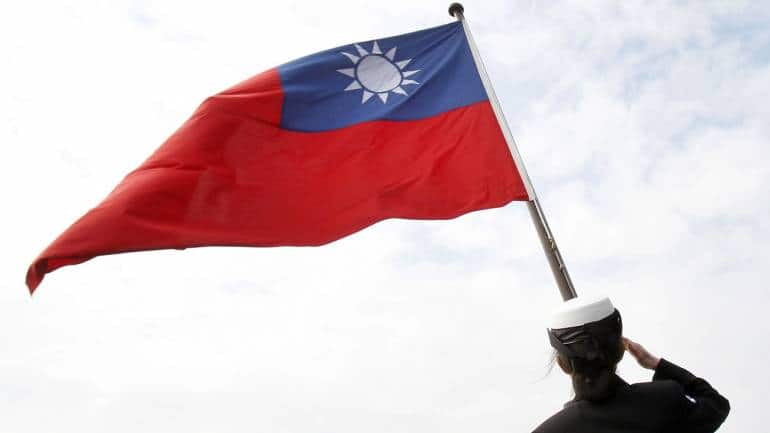Taiwan cancels flights as weakened Typhoon Chanthu approaches
 ]
]
The centre of the storm is expected to travel up Taiwan’s eastern seaboard overnight but remain out to sea. (Representative image)
Typhoon Chanthu weakened on Saturday as it approached Taiwan’s eastern coast and was unlikely to make landfall, meteorologists said, but strong winds left more than 100 flights and ferries cancelled.
Chanthu rapidly formed into a super typhoon in just 48 hours earlier this week threatening both the Philippines and Taiwan.
But it was since downgraded to a medium storm and will likely avoid hitting Taiwan directly according to the island’s central weather bureau.
The outer edge of the storm was lashing eastern and southern Taiwan with strong winds and rains on Saturday night after it grazed the northeastern tip of the Philippines.
“Taiwan will be under the influence of the typhoon from tonight to whole day tomorrow as winds and rains are expected to increase all over (the island)” forecaster Wu Wan-hua said.
The centre of the storm is expected to travel up Taiwan’s eastern seaboard overnight but remain out to sea.
At 1200 GMT, Chanthu was 100 kilometres (62 miles) east of Taiwan’s southernmost tip, packing gusts of up to 198 kilometres an hour, the bureau said.
Around 2,000 people in landslide-prone areas in eastern Hualien county have been evacuated and authorities also closed some sections of highways in the area.
Around 100 local and international flights, as well as ferry services to several offshore islets, were suspended on Saturday, according to the central emergency operation centre.
The defence ministry said it has 31,000 troops on standby for typhoon relief work if needed.
Taiwan is regularly hit by tropical storms in the summer months.
In a rare exception to the rule, not a single typhoon made landfall last year, the first time in 56 years. The last typhoon to make landfall on the island was in August 2019.
That helped fuel the worst drought in decades until heavy rains set in a few months ago and brought needed relief.
Gaining from cyclical recovery: Here’s why you must invest in Brazil, Taiwan and Russia
 ]
]
Global equity markets (as gauged by the MSCI ACWI index) continued advancing to record highs in 2Q21, despite investors’ growing cautiousness. The first half of 2Q21 was marked by more re-opening (led by Europe), rising global inoculation rate, and above-consensus inflation reading. This led to stronger performance in cyclicals and recovery sectors, as well as a broader risk-on undercurrent, which helped lift global equities higher.
The second half of 2Q21, however, told a markedly different tale. Markets were anything but calm, with the Fed’s hawkish tilt, concerns over the timeline for monetary tightening, heightened fears over the delta variant spread, and the collapse in 10-Year US treasury yields. This triggered an unwinding of reflation and recovery trade, sending investors back towards Growth and Defensive sectors. As the risk-on tone began to deflate, global equities traded mostly flat from late May.
In this scenario, our top three performers in the second quarter were Brazil (+25.20 percent), Russia (+13.48 percent), and Taiwan (+10.48 percent) (in USD terms).
Taiwan
Taiwan’s equity market (Benchmark: TWSE Index) ran into a speed bump in 2Q21 after a resurgence in COVID-19 infections in mid-May. Nonetheless, i) optimism of an export-driven recovery (strong export growth numbers since April), complemented by ii) strong performance from cyclical sectors (industrials, materials, consumer discretionary and financials), as well as iii) robust semiconductor demand lifted the TWSE Index.
Equity Outlook
Taiwan’s growth outlook remains resilient. We believe the outstanding export numbers should provide a buffer for Taiwan’s domestic demand malaise, limiting macro downside risks for investors.
Taiwanese equities’ biggest driver, its semiconductors industry (almost 40 percent of the index), remains in a positive position. It should experience a structural uplift from the reshoring of investment and production due to higher tariffs on mainland China. We also expect the demand for semiconductors to remain tight for ’21 and possibly ‘22, fueled by secular (digitalization, cloud computing) and cyclical factors (new mobile phone releases in Sep-Oct, holiday season demand for electronics).
The stated factors suggest that potential valuation expansion may be met by upside in earnings, keeping valuation (forward PE ratio) for Taiwan equities manageable moving forward. Valuation - in terms of forward FY1 PE - is currently fairly valued at 14.7X, which is in line with the historical average.
Chart1: Taiwan equities’ price performance and EPS
Key risks
The COVID-19 resurgence can threaten Taiwan’s resilient growth via a larger hit on its services sectors due to low inoculation rate. Achieving herd immunity should become a top priority to mitigate exposure to this risk.
Secondly, we see a minor risk of an inventory correction in semiconductors sometime down the line when the supply-demand disequilibrium resolves itself. This can hurt the tech-heavy TWSE Index.
Russia
Russia’s performance (Benchmark: RTS Index) in 2Q21 was chiefly driven by higher energy prices. In 2Q alone, prices of Brent crude oil gained 18 percent while natural gas gained 44 percent. This drove strong performance in Russia’s energy sector (around 45 percent of the index), which accounted for at least 50 percent of 2Q’s total return.
Equity Outlook
Russia’s growth outlook remains stable, with nothing too glaringly positive or negative. Macro headwinds, such as monetary tightening and ongoing pandemic risk, are fairly balanced with tailwinds, such as higher oil prices and rising inoculation rate.
Equities fundamentals enjoy strong support by energy prices, which we believe have limited near to mid-term downside given positive supply-demand dynamics and pro-inflation backdrop. As a result of the surge in energy prices and the high exposure to commodity (and related) sectors, we anticipate robust cyclical earnings rebound.
In our view, investing in Russia is about finding the balance between political risk, oil market outlook, and upside potential. Looking ahead, we believe the potential upside - both price and dividend - provides a good compensation.
Key risks
Balancing political risk is part of investing in Russian equities. Also, with Russia being ahead in the EM monetary tightening cycle, a potential slowdown – not contraction – in growth momentum remains a macro risk. Above target inflation readings and the Fed’s hawkish pivot has prompted front-loaded rate hikes in Russia.
We think the number of rate hikes should be kept in view (fine balance to curb inflation) as tightening tends to result in slower growth, which may be bad amidst the spread of the delta variant.
Chart 2: Russia equities’ price performance and EPS
Brazil
Brazilian equity market’s (Benchmark: Bovespa Index) performance in 2Q 2021 was fueled by i) a boost from cyclicals and re-opening sectors, and ii) significant currency appreciation. Cyclical sectors account for almost 75 percent of the Bovespa index, and Energy and Materials are the major return drivers, accounting for at least 60 percent of 2Q’s total return.
Equity Outlook
Brazil’s macroeconomic outlook has improved in recent months owing to stronger global demand and easing of restrictions. Growth should remain resilient in 2H21 and beyond, on the back of a rising inoculation rate.
At the moment, rate hikes are unlikely to slow growth and that should be balanced by growth upside unlocked from possible growth-boosting reforms (tax reforms and privatization) enacted before Brazil’s 2022 election.
Brazilian equities, in aggregate, are projected to generate staggering earnings growth, driven by base effect and a robust cyclical EPS recovery. Brazilian equities’ strong EPS rebound and upwards revision greatly outweigh their EM peers, making them relatively more attractive from a fundamental perspective. In our view, the biggest positive factor for Brazilian equities will be its deep discount.
At the moment, we see Brazilian equities as a high-risk high-reward play that is skewed positively - towards the ‘reward’ side - due to positive market and idiosyncratic factors. Equity outlook remains constructive entering 2H21, especially amongst the EMs.
Key risks
Brazilian equities do come with a higher risk, specifically driven by two scenarios that investors should keep in view in 2H21 and beyond.
A potential escalation in the ongoing political scandal revolving Bolsonaro (Brazil’s current president) can undermine investor’s confidence and ultimately drive outflows from Brazilian equities and currency, resulting in a double-whammy for equity returns.
A potential worsening of the delta variant spread will put Brazil’s growth back in a precarious position. Policymakers have to either continue with their rate hike, to stem out inflationary pressure, or reverse hiking decisions to bolster growth and run the risk of out-of-control inflation.
Chart 3: Brazilian equities’ price performance and EPS
Conclusion
Investors who wish to invest in emerging markets can consider quality funds that invest in these countries. You can opt for investment through SIPs to ensure cost averaging through staggered investing. Investors should look at volatile market phases as an opportunity to invest and should continue their investments.
The medium to long term investment horizon is ideal to reap the compounding benefits. From a tax perspective, units that are held for at least three years from the date of purchase should receive the indexation benefit.
Taiwan scrambles jets against renewed Chinese military activity
 ]
]
Chinese Taipei - Chinese Taipei stood fifth in the number of road accidents recording 305,556 road accidents during 2018 with 403,906 injured. The number of deaths during the same year stood at 1604. Chinese Taipei has one of the lowest road networks in the world.
Taiwan’s air force scrambled on Sunday against renewed Chinese military activity, with its defence ministry reporting that 19 aircraft including nuclear-capable bombers had flown into Taiwan’s air defence identification zone.
Chinese-claimed Taiwan has complained for a year or more of repeated missions by China’s air force near the self-ruled island, often in the southwestern part of its air defence zone near the Taiwan-controlled Pratas Islands.
The latest Chinese mission involved 10 J-16 and four Su-30 fighters, as well as four H-6 bombers, which can carry nuclear weapons, and an anti-submarine aircraft, Taiwan’s Defence Ministry said.
Taiwanese combat aircraft were dispatched to warn away the Chinese aircraft, while missile systems were deployed to monitor them, the ministry said.
The Chinese aircraft flew in an area closer to the Chinese than Taiwanese coast, roughly northeast of the Pratas, according to a map provided by Taiwan’s defence ministry.
There was no immediate comment from China.
The last such large-scale activity, on June 15, involved 28 Chinese air force aircraft, the largest incursion https://www.reuters.com/world/asia-pacific/taiwan-reports-largest-incursion-yet-by-chinese-air-force-2021-06-15 reported by Taiwan to date.
China often mounts such missions to express displeasure at something Taiwan has done or at shows of international support for the democratically ruled island, especially by the United States, Taiwan’s main arms provider.
It was not clear what might have prompted China to launch its aircraft this time, though a U.S. warship and a U.S. Coast Guard cutter sailed through the Taiwan Strait late last month.
China has described its activities as necessary to protect the country’s sovereignty and deal with ”collusion” between Taipei and Washington.
Taiwan’s defence ministry warned last week that the threat from China was growing, saying China’s armed forces can ”paralyse” Taiwan’s defences and are able to fully monitor its deployments.